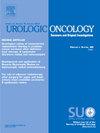Vigorous physical activity as a potential environmental risk factor in renal medullary carcinoma
IF 2.3
3区 医学
Q3 ONCOLOGY
Urologic Oncology-seminars and Original Investigations
Pub Date : 2025-07-04
DOI:10.1016/j.urolonc.2025.06.012
引用次数: 0
Abstract
Purpose
Renal medullary carcinoma (RMC) is a rare but aggressive kidney cancer affecting young individuals with sickle hemoglobinopathies. Prior retrospective case-control and mouse modeling studies suggest a mechanism linking vigorous intensity physical activity to increased RMC risk in individuals with sickle hemoglobinopathies. This study aimed to prospectively investigate the association between vigorous intensity exercise and RMC.
Materials and methods
This study used a validated questionnaire to prospectively assess reported physical activity in a large cohort of patients with RMC compared to the activity of individuals without RMC. Between 2022 and 2024, patients with RMC (N = 39) were prospectively surveyed using the validated Physical Activity Questionnaire from the National Health and Nutritional Examination Survey and compared to responses of a national cohort of healthy individuals (N = 7148). This questionnaire is designed to distinguish between vigorous, moderate, and sedentary activity. To further validate the questionnaire, we performed body-composition analysis to determine if patients reporting vigorous activity had increased skeletal muscle mass and decreased subcutaneous adipose tissue.
Results
Individuals had higher odds of RMC diagnosis if reporting vigorous intensity physical activity at work (OR 2.91, 95% CI 1.50–5.66; P = 0.002) or recreationally (OR 4.02, 95% CI 1.85–8.74; P < 0.001) after adjusting for age, biologic sex, and race. Body composition analysis confirmed that patients reporting vigorous physical activity were more likely to have a higher skeletal muscle mass index (median 54.3 vs. 41.2 cm2/m2; P = 0.01) compared to patients not reporting vigorous physical activity.
Conclusion
These results prospectively support the association between vigorous physical activity and RMC in individuals with sickle hemoglobinopathies.
剧烈运动是肾髓质癌的潜在环境危险因素。
目的:肾髓质癌(RMC)是一种罕见但侵袭性的肾癌,影响镰状血红蛋白病的年轻人。先前的回顾性病例对照和小鼠模型研究表明,在镰状血红蛋白病患者中,高强度体育活动与RMC风险增加有关。本研究旨在前瞻性探讨高强度运动与RMC之间的关系。材料和方法:本研究采用一份经过验证的问卷,前瞻性地评估了一大批RMC患者与非RMC患者的身体活动情况。在2022年至2024年期间,使用国家健康和营养检查调查中有效的身体活动问卷对RMC患者(N = 39)进行了前瞻性调查,并将其与国家健康人群(N = 7148)的回答进行了比较。这份问卷旨在区分剧烈运动、适度运动和久坐不动的运动。为了进一步验证问卷,我们进行了身体成分分析,以确定报告剧烈运动的患者是否骨骼肌质量增加,皮下脂肪组织减少。结果:报告在工作中剧烈运动的个体有较高的RMC诊断几率(OR 2.91, 95% CI 1.50-5.66;P = 0.002)或娱乐性(or 4.02, 95% CI 1.85-8.74;P < 0.001),校正了年龄、生理性别和种族。身体成分分析证实,报告剧烈运动的患者更有可能具有较高的骨骼肌质量指数(中位数54.3 vs. 41.2 cm2/m2;P = 0.01),与未报告剧烈运动的患者相比。结论:这些结果前瞻性地支持镰状血红蛋白病患者剧烈运动与RMC之间的关联。
本文章由计算机程序翻译,如有差异,请以英文原文为准。
求助全文
约1分钟内获得全文
求助全文
来源期刊
CiteScore
4.80
自引率
3.70%
发文量
297
审稿时长
7.6 weeks
期刊介绍:
Urologic Oncology: Seminars and Original Investigations is the official journal of the Society of Urologic Oncology. The journal publishes practical, timely, and relevant clinical and basic science research articles which address any aspect of urologic oncology. Each issue comprises original research, news and topics, survey articles providing short commentaries on other important articles in the urologic oncology literature, and reviews including an in-depth Seminar examining a specific clinical dilemma. The journal periodically publishes supplement issues devoted to areas of current interest to the urologic oncology community. Articles published are of interest to researchers and the clinicians involved in the practice of urologic oncology including urologists, oncologists, and radiologists.

 求助内容:
求助内容: 应助结果提醒方式:
应助结果提醒方式:


